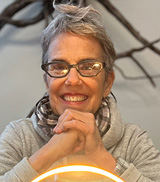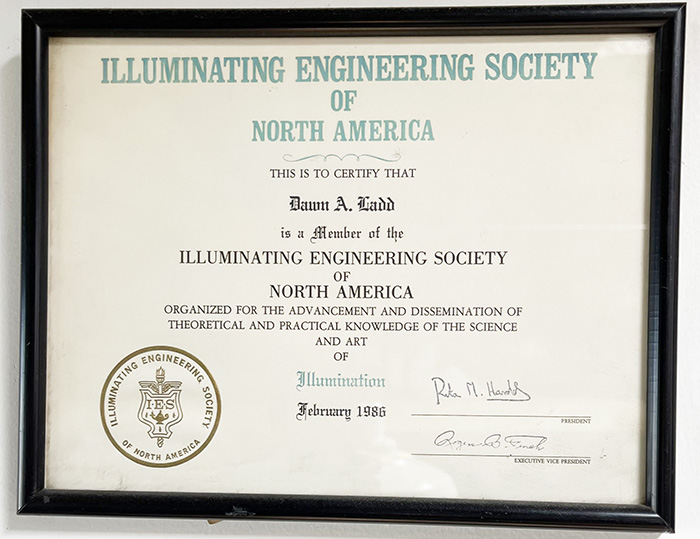Meet Our Member
The IESNYC spotlights a member each month whose volunteerism, perspectives or personal story helps advance our goals, pique our curiosity, and whose contributions help the IESNYC become a more vibrant and diverse lighting community. We value their expertise and thank them for volunteering their time and energy for the betterment of the section and NYC Lighting Community. #the_iesnycmom
May 2023
 Dawn Ladd
Dawn Ladd
Principal
Aurora Lampworks Inc.
Q: How did you first get started in the lighting industry?
You know how some people’s names somehow correspond to their profession? Well, it’s apt because my mother named me Dawn, after the morning’s first light in the sky. In keeping with that, I had a friend who was 98 years old (a world traveler and the first woman to graduate from Yale). She suggested I name my company Aurora, after the Roman goddess of the dawn.
My first fascination with lighting came in London when I was in my thirties. Harrods department store had an entire floor dedicated to Art Deco. It was amazing and immersive. I’d never seen anything like it. A mauve lampshade caught my eye. The light coming through the fabric and fringe… I fell in love with it! I brought it home on the plane on my lap.
When I got back to New Haven, I asked a friend, a seamstress, to make something similar. Soon we were making lampshades full time, and I was sourcing wire frames from a Russian immigrant (a former rocket scientist) in SoHo. All my interior design and antique dealer friends seemed to have a stunning old lamp that needed a new shade, and often rewiring. We made lampshades in all sorts of shapes and colors. I was down on Canal Street once a week finding textiles, beads, and accessories. It was one of the most creative times in my career.
I opened a small shop in New Haven, and Yale University discovered my small company. I worked on spaces all over the campus, acting as a self-taught lighting designer for the maintenance department.
At Yale I learned the bureaucracy of priorities: the maintenance department versus the security department versus the campus architects and historians. I demonstrated different lamp options and let them decide for themselves. (To this day, I empathize with the lighting designers I work with, because they too have to weigh all those competing interests.)
After I opened my showroom, I met a woman who wanted to manufacture lamps. Rachel Simon and I started Lights Up in New Haven. In the eighties we made portable lamps for retailers like Crate and Barrel and Pottery Barn. Eventually, we moved the company to New York. Along the way, as much as I appreciated my hard-working partner, I realized that I preferred restoring historic lighting fixtures to production. We merged our manufacturing business with George Kovacs Lighting, where Rachel continued. I reopened Aurora Lampworks in New York in 1990 and began doing larger-scale restoration projects.
All this to say, my 40-year career in lighting began with a mauve lampshade with 10 inch fringe. It still hangs in my office to remind me of my journey.
Q: How did you first get involved in the IESNYC? The main impetus for my involvement with IESNYC was Megan Carroll, back when we both lived in New Haven. She was deeply involved in the Society and the local lighting community. Megan was also responsible for getting me involved in other IES events, including one in Kentucky where I was one of the keynote speakers. There are so many different roads to the lighting industry, and I think I’ve had a taste of just about all of them. I like to remind young people starting out that the lighting industry has so many facets and opportunities.
The main impetus for my involvement with IESNYC was Megan Carroll, back when we both lived in New Haven. She was deeply involved in the Society and the local lighting community. Megan was also responsible for getting me involved in other IES events, including one in Kentucky where I was one of the keynote speakers. There are so many different roads to the lighting industry, and I think I’ve had a taste of just about all of them. I like to remind young people starting out that the lighting industry has so many facets and opportunities.
Q: In your opinion, what are the best assets of the IESNYC?
I love being in the company of lighting designers and work with them often. There’s a small group of us that can “see” light in a uniquely professional way. Somewhere along the line, we were all bitten by the “lighting bug.” It's great to be able to talk with professionals who can speak the jargon and envision what we’re trying to convey verbally and on paper. Transmissivity, glow, glare, color temperature…the mother tongue of lighting. The IESNYC educational programs, along with other organizations in the community, have an important role in disseminating lighting information and standardizing the nomenclature.
The IES is an important resource, no matter which path one takes in the field of lighting.
A major resource for lighting information is Lightfair, which the IESNYC helped to found. Aurora’s staff are encouraged to go and see all the new hardware and innovations, and attend some seminars. So, when we get a request from a lighting designer, we have an idea of the latest sources and drivers and how they might integrate into the fixture. I think those connections and know-how put Aurora in a unique position to help lighting professionals achieve their goals.
Aurora has contributed to several projects that received Lumen Awards over the years, and I remember the gala when Paul Marantz got his Golden Achievement Award. It’s wonderful that the Lumens recognize talented designers. I have a good idea of what must have gone into those projects and how all the interests are balanced, which can be years in the making. It makes me proud to know that hard and thoughtful work is recognized.
2025 IESNYC Event and Educational Sponsors
Brilliant Sponsors
Radiant Sponsors
Glow Sponsors
Sparkle Sponsor
Twinkle Sponsors
Available Light | Hartranft Lighting Design | HLB Lighting Design
